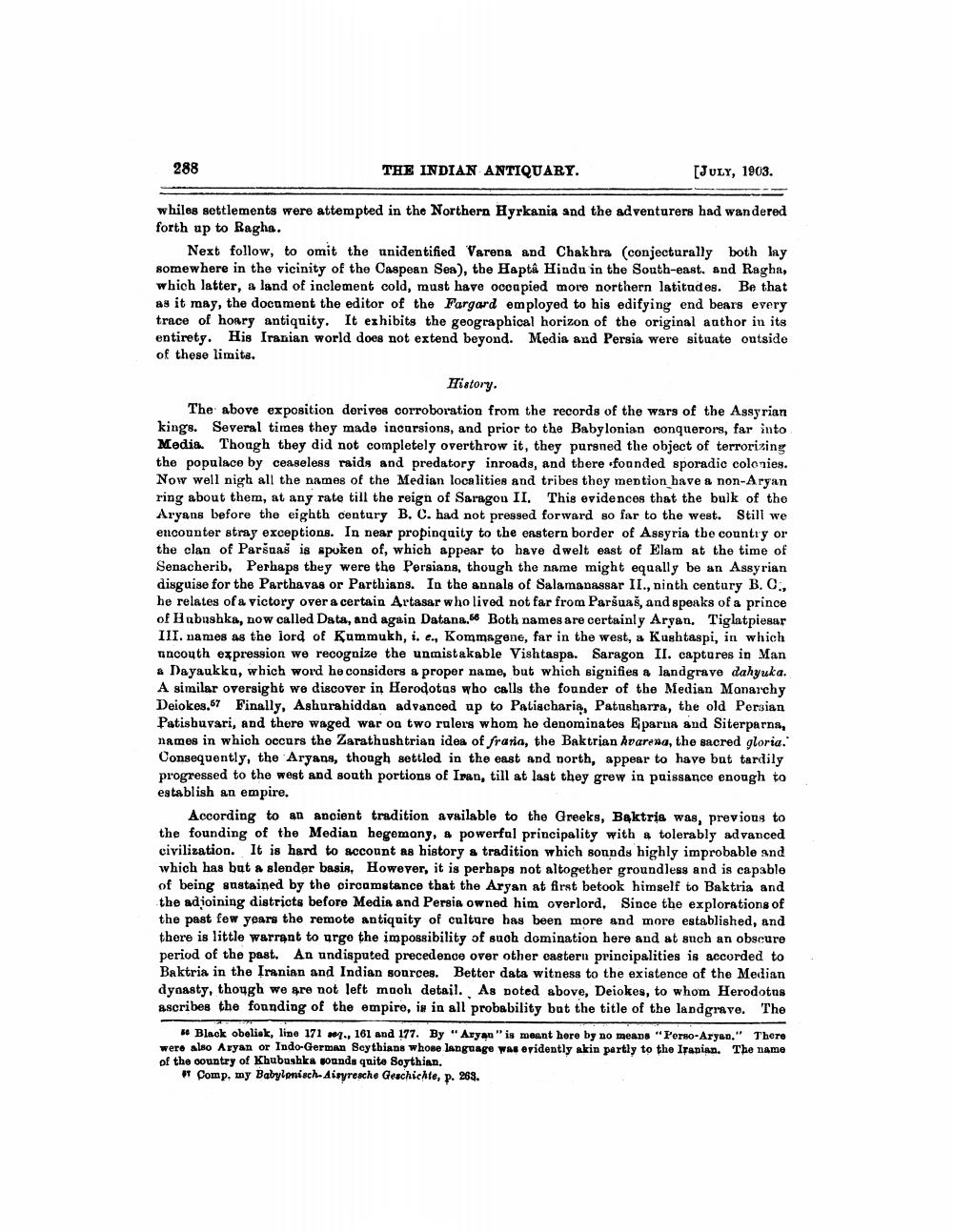________________
288
THE INDIAN ANTIQUARY.
[JULY, 1903.
whilos settlements were attempted in the Northern Hyrkania and the adventurers had wandered forth up to Ragha.
Next follow, to omit the unidentified Varena and Chakhra (conjecturally both lay somewhere in the vicinity of the Caspean Sea), the Haptâ Hindu in the South-east, and Ragha, which latter, a land of inclement cold, must have occapied more northern latitudes. Be that as it may, the document the editor of the Fargard employed to his edifying end bears every trace of honry antiquity. It exhibits the geographical horizon of the original author in its entirety. His Iranian world does not extend beyond. Media and Persia were situate outside of these limits.
History. The above exposition derives corroboration from the records of the wars of the Assyrian kings. Several times they made incursions, and prior to the Babylonian conquerors, far into Media. Though they did not completely overthrow it, they pursned the object of terrorizing the populace by ceaseless raids and predatory inroads, and there founded sporadic colonies. Now well nigh all the names of the Median localities and tribes they mention have a non-Aryan ring about them, at any rate till the reign of Saragon II. This evidences that the bulk of the Aryans before the eighth century B. C. had not pressed forward so far to the west. Still we encounter stray exceptions. In near propinquity to the eastern border of Assyria tbe country or the clan of Parsuas is spoken of, which appear to have dwelt east of Elam at the time of Senacherib. Perhaps they were the Persians, though the name might equally be an Assyrian disguise for the Parthavas or Parthians. In the annals of Salamanassar II., ninth century B.O., he relates of a victory over a certain Artasar who lived not far from Parsuas, and speaks of a prince of Hubushka, now called Data, and again Datana.66 Both names are certainly Aryan, Tiglatpiesar III. names as the lord of Kummukh, i. e., Kommagene, far in the west, a Kushtaspi, in which uncouth expression we recognize the unmistakable Vishtaspa. Saragon II. captures in Man a Dayaukku, which word he considers a proper name, but which signifies a landgrave dahyuka. A similar oversight we discover in Herodotas who calls the founder of the Median Manarchy Deiokes.67 Finally, Ashurahiddan advanced ap to Patiacharia, Patusharra, the old Persian Patisbuvari, and there waged war oa two ralers whom he denominates Eparna and Siterparna, names in which occurs the Zarathushtrian idea of fraria, the Baktrian kvarena, the sacred gloria. Consequently, the Aryans, though settled in the east and north, appear to have but tardily progressed to the west and south portions of Iran, till at last they grew in puissance enough to establish an empire.
According to an ancient tradition available to the Greeks, Baktris was, previous to the founding of the Median hegemony, & powerful principality with a tolerably advanced civilization. It is hard to account as history a tradition which sonnds highly improbable and which has but a slender basis. However, it is perhaps not altogether groundless and is capable of being sustained by the circumstance that the Aryan at first betook himself to Baktria and the adjoining districts before Media and Persia owned him overlord. Since the explorations of the past few years the remote antiquity of culture has been more and more established, and there is little warrant to urge the impossibility of such domination here and at such an obscure period of the past. An undisputed precedence over other eastern principalities is accorded to Baktria in the Iranian and Indian sources. Better data witness to the existence of the Median dynasty, though we are not left mooh detail. As noted above, Deiokes, to whom Herodotus ascribes the founding of the empire, is in all probability but the title of the landgrave. The
* Black obeliok, line 171 101., 161 and 177. By "Aryan" is meant here by no means "l'orso-Aryan." There were also Aryan or Indo-German Beythians whose language was ovidently akin partly to the Iranian. The name of the country of Khubushka sounds quite soythian.
Comp, my Babylonisch-Airyresche Geschichte, p. 268.




